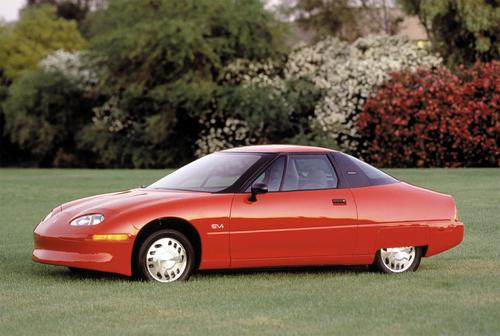Even today, if you want to make an engineer's blood boil, there's a good chance you can do it by mentioning General Motors' EV1, produced from 1996 to 1999. For many, the subject conjures up images of truckloads of cars being needlessly hauled off to the crusher.
A significant number of engineers, who have torn down and evaluated electric cars, see the EV1 as a monument to the art of automotive engineering. If it used today's lithium-ion batteries, they say, no electric vehicle ever made could touch it.
"When it comes to pure electric vehicles, the EV1 is still the best that's been built in the last 15 years," noted one engineer, who didn't want to be named for competitive reasons, but who has torn down and evaluated every production EV that's been made since the early 1990s. "The EV1 was a fully-developed, all-around vehicle. Today, no one has the resources to do what GM did."
For those who don't remember it well, here's a short primer on the EV1. Introduced by General Motors (GM) in 1996, the EV1 was a two-seat electric coupe that was designed from the ground up with the best technologies available at the time. It was one of the first vehicles to use an aluminum spaceframe, which made it about 40 percent lighter than steel.
Engineers then joined the frame with aerospace-grade structural adhesives, thereby eliminating many of the welds. They also made body panels from composites -- again, to cut weight -- and added a lightweight suspension with help from Lotus Engineering. Moreover, the vehicle had the most advanced power electronics available at the time, and GM engineers spent thousands of hours matching the EV1's AC induction motors to the vehicle.Materials weren't the only way of boosting the EV1's energy efficiency, however. Design engineers used low-rolling-resistance tires and sculpted the body down to drag coefficient of 0.195, which is still considered by Wikipedia to be the lowest in the history of production cars. By comparison, the Chevy Volt reportedly has a Cd of 0.28 and the Nissan Leaf, 0.29. Both of those figures are better than the auto industry's average of 0.35 to 0.45, but still far short of the EV1's.
The result was that a modified EV1 captured an electric vehicle speed record in 1997, hitting 183mph.

(Photo courtesy of GM.)
"It's better than the Leaf," our contact told us. "And the Tesla -- which is certainly faster but costs $120,000 -- still is far less sophisticated that the EV1."
There is, of course, the issue of the battery. The EV1's Gen2 version employed a nickel-metal hydride pack, which had an energy density of about 90Wh/kg. In comparison, today's lithium-ion batteries reach 140Wh/kg. The higher energy density enables today's EVs to cut weight.
Even there, however, is still a small debate. The EV1 supposedly offered 160 miles of range (a doubtful figure, by today's EPA criteria), but even if we cut that down to 100 miles, it's still more than Nissan Leaf's. What's more, many engineers don't like the Tesla Roadster pack, which employs 6,800 "18650" batteries (each slightly larger than an AA), connected in series.
Either way, they say, the EV1's supremacy would be beyond debate if it had today's battery packs. "The new battery would mean the EV1 could be about 500 lbs lighter (than the others) for the same range," our contact said. "But aside from that, the EV1 wouldn't need to change. It was that advanced."
To be sure, not everyone agrees with that assessment. As late as 2008, Time Magazine placed the EV1 on its list of "The 50 Worst Cars of All Time." What's more, many EV1 detractors have reasonably pointed out that GM spent between $80,000 and $100,000 per vehicle, which is a debatable figure, but one that nevertheless suggests that a comparison of the EV1 and the Leaf isn't appropriate. Finally, there's the issue of size -- the EV1 seated just two people.
Still, it's hard to argue that the vehicle's engineering was far ahead of its time.
"Microelectronics, miniaturization, better batteries -- all of those things have happened since the introduction of the EV1," our contact said. "But the results don't indicate that we've gotten that much out of it. Yes, we've got better batteries today, but imagine what the EV1 could have done with those batteries."
Source: DesignNews



No comments:
Post a Comment